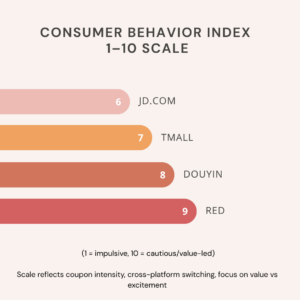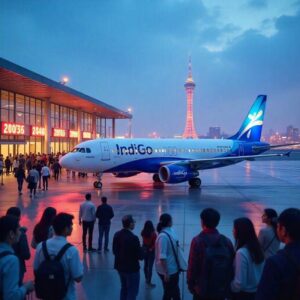Singles Day 2025 struck a curious chord. Big numbers played out against a backdrop of caution!
Singles Day 2025 stretched across nearly a month. But even with the buzz spread thin, it still hit a new GMV high. The gross merchandise value (GMV) reached about ¥1.7 trillion (roughly $240 billion), up ~17% year-on-year.

Shoppers showed up with wallets still zipped shut. Consumer sentiment felt “muted”. In a market stung by property woes and job uncertainty, buyers didn’t line up for freebies, they hunted for bargains. One Beijing shopper quipped that she spent Singles Day like any other day: “Every day feels like a shopping holiday anyway”.
The sale was built on deals, not desire. Brands packed their storefronts with coupons. Alibaba alone handed out ¥50 billion in perks to its 88VIP members, pushing daily active buyers up 39%. Chinese shoppers weren’t swept up in the hype. They were calculating. They knew what they wanted, and they waited for the right price.

Electronics & Beauty Reign
The usual suspects held court. Tech gadgets led the charge: Apple’s new iPhone 17 series and Xiaomi’s latest phones flew off virtual shelves, thanks to big product launches in September. In fact, Taobao data shows 80 brands each crossed the ¥100 million mark in sales within the first hour of the festival.
Beauty and skincare played by their own rules; demand stayed strong while other categories slowed. In mere minutes eight top cosmetics brands each racked up ¥100 million. Popular beauty products, from L’Oréal’s Revitalift serums to Lancôme’s Génifique creams, quickly sold out of virtual shelves. These were the products consumers really needed, not just flashy deals.

Even physical stores got in on the act. Major malls in Shanghai and beyond logged about 25–30% more foot traffic during Singles Day weekend, blending offline excitement with the online rush.
Still, digital commerce ruled: Alibaba’s Tmall quietly notched its strongest GMV growth in four years, while JD.com smashed records. 40% more shoppers placed orders and overall order volume jumped nearly 60%. China’s top platforms may have skipped the glitz of big countdown events this year, but the sale marched on behind the scenes.
Livestream Shopping Takes Center Stage

Livestream shopping on platforms like Douyin and Taobao Live turned up the volume. During the festival, over 67,000 brands on Douyin literally doubled their sales year-on-year. Big-name hosts (Li Jiaqi, Viya and dozens more) and countless rising livestreamers broadcasted product demos, bringing goods straight into millions of homes. From late October through Singles Day itself, almost 180,000 livestreams ran across Taobao and Douyin. Beauty and fashion alone accounted for nearly 20% of that GMV.

Brands that leaned into live strategies saw immediate payoffs. The playbook was clear: hook viewers with emotion-packed short videos on Douyin, then reel them into Tmall or JD.com to close the deal. Think of it like a relay race – Douyin passes the baton, Tmall’s checkout crosses the finish line.
Nike and Adidas jumped in with surprise sneaker drops on Taobao Live; beauty houses held interactive skincare tutorials. Even Alibaba’s AliExpress hosted a London live-show for Chinese toy fans. The result was a festival that felt more like a week of blockbuster product launches than a one-day mega-sale.

AI & Tech Fuel the Sale
Under the hood, China’s Singles Day ran on AI and tech. On the merchant side, new tools crunched data to optimize prices, ad spend and inventory. Imagine software that automatically triggers flash-price cuts when demand spikes, or shifts ad budget mid-campaign to the hottest products.
Retailers also deployed AI chatbots to answer buyer questions on the spot, and voice assistants (Tmall Genie) to simplify search and checkout. Some brands even experimented with virtual try-on tools and 3D product views.

For consumers, shopping became more personal. AI-driven recommendations tailored the sale to each user’s tastes. In-app chat features let shoppers get instant tips from friends or influencers as they browsed.
The upshot: even amidst fireworks of discounts, the experience felt surprisingly smooth and personalized.
What are the takeaways for brands?

A big lesson is that hype alone no longer sells. Shoppers want value and meaning with their deals. Campaigns that told a story – a self-care ritual, a practical home upgrade, a gift with purpose – resonated more than empty slogans. Smart brands kept pricing fair and packaging clear, because today’s Chinese consumers aren’t fools for gimmicks. One livestream seller in Shenzhen offered just a 15% discount this year (down from ~40% last year) and saw his sales revenue drop ~30–40%, even though his profit margin doubled.
Loyalty paid off. Alibaba’s 88VIP members (high-spend frequent buyers) went big this year, underscoring that repeat customers remain a powerhouse. And grassroots communities drove engagement: brands that connected with key KOLs on Douyin or niche RED forums turned casual viewers into repeat fans. In short, building a genuine narrative and staying consistent across channels earned trust.
Ultimately, China’s Singles Day 2025 showed that the market is big but matured. Consumers are confident but choosy. They are prioritizing essentials, health and quality upgrades.

Got a China ecommerce challenge? Let’s talk. Drop us a line at Digital Crew – we’ll help you turn the next Singles Day into your success story.
In summary
Singles Day 2025 broke sales records, but not because shoppers splurged blindly. Consumers hunted for value, jumped across platforms, and followed creators who knew their stuff. Beauty stayed strong. Livestreaming exploded. And behind it all? Smarter buyers, sharper brands, and AI pulling strings in the background. Singles Day 2026 won’t be about louder discounts, it’ll be about better decisions.






















